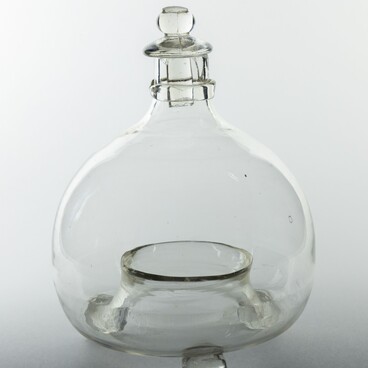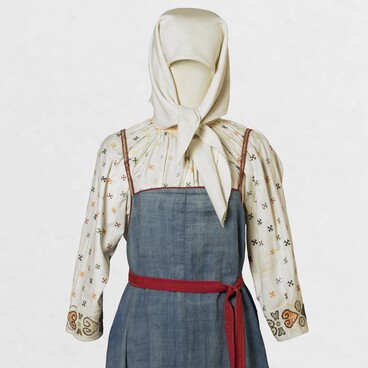Clothing is a mirror of folk culture. It reflects the history, ethnicity, religious affiliation, age and social status of people. The Udmurts are one of the indigenous peoples of the Kama region from the Finno-Ugric language family. They live in Udmurtia, the Kirov Oblast, the Mari El Republic, Tatarstan, Bashkiria, Mordovia, Perm Krai and the Sverdlovsk Oblast.
Each ethnographic group of the Udmurts is characterized by its own unique cut of clothing, manner of wearing, ornaments and jewelry. The exhibition of the Glazov Museum of Local Lore presents a women’s dress that was in use in the northern regions of Udmurtia in the second half of the 19th — early 20th century. It consists of a tunic-like shirt with a robe on top of it, a bib, an apron and a scarf.
In terms of the manufacturing method of the dress, the homespun cloth for the shirt was bent horizontally and the neck was cut out at the bend. The sleeves were woven separately on a loom, and then sewn perpendicular to the main canvas. The patterns on them were woven in the technique of discontinuous weft weaving. Each elements of the pattern had its own meaning: the eight-pointed star tolez symbolized the moon, the rhombus — fields, and dots — seeds and grains.
The shirt’s neckline was covered with a bib, richly ornamented in the applique technique. The bib was an element of a married woman’s clothing that protected her from the evil eye. A robe was worn over the shirt and the bib. Women belted their apron that was woven using multiple heddles. On holidays, an elegant patterned belt was tied over the apron. It was made on a mini loom — a wooden weaving board.
Married Udmurt women wore a triangular shawl to cover their hair. They wore stockings, footwraps and lapti (a type of footwear usually made of bast). The summer version was woven from bast, and the winter one was made of birch bark. Birch bark lapti were denser, stiffer and wicked moisture. For softness and hygiene, straw insoles were placed inside the bast shoes.
The main colors in the clothing of the northern Udmurt woman were red (the color of fire and sun) and white (the color of purity). The traditional national Udmurt dress served not only aesthetic, but also protective purposes as it guarded the wearer against external troubles and the evil eye.
Each ethnographic group of the Udmurts is characterized by its own unique cut of clothing, manner of wearing, ornaments and jewelry. The exhibition of the Glazov Museum of Local Lore presents a women’s dress that was in use in the northern regions of Udmurtia in the second half of the 19th — early 20th century. It consists of a tunic-like shirt with a robe on top of it, a bib, an apron and a scarf.
In terms of the manufacturing method of the dress, the homespun cloth for the shirt was bent horizontally and the neck was cut out at the bend. The sleeves were woven separately on a loom, and then sewn perpendicular to the main canvas. The patterns on them were woven in the technique of discontinuous weft weaving. Each elements of the pattern had its own meaning: the eight-pointed star tolez symbolized the moon, the rhombus — fields, and dots — seeds and grains.
The shirt’s neckline was covered with a bib, richly ornamented in the applique technique. The bib was an element of a married woman’s clothing that protected her from the evil eye. A robe was worn over the shirt and the bib. Women belted their apron that was woven using multiple heddles. On holidays, an elegant patterned belt was tied over the apron. It was made on a mini loom — a wooden weaving board.
Married Udmurt women wore a triangular shawl to cover their hair. They wore stockings, footwraps and lapti (a type of footwear usually made of bast). The summer version was woven from bast, and the winter one was made of birch bark. Birch bark lapti were denser, stiffer and wicked moisture. For softness and hygiene, straw insoles were placed inside the bast shoes.
The main colors in the clothing of the northern Udmurt woman were red (the color of fire and sun) and white (the color of purity). The traditional national Udmurt dress served not only aesthetic, but also protective purposes as it guarded the wearer against external troubles and the evil eye.






